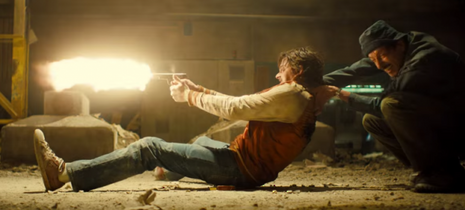Review: Does ‘Free Fire’ hit its target?
Lillian Crawford laughs and winces through Ben Wheatley’s hilariously brutal shootout film, regrettably in an empty cinema

Ben Wheatley appears to have been ascribed the ambiguous epithet of ‘the director that makes the films he wants to make’. While this is certainly not unique among cult directors, it comes close to identifying the individuality of his films. He set off with a Mike-Leigh-Ken-Loach-like crime story in Down Terrace, took a U-turn down a road of bone-rattling terror in Kill List, via the raucous black comedy of caravan parks of Sightseers, past the historical psychedelic drugs horror of A Field in England, then soared up the High Rise with Thatcher-bashing chaos last year. On that already wild ride, Wheatley has established his own trademarks, his inescapably British style, which thus far may have limited the scope of his audience.
“At times this feels as anachronistic as John Denver’s ‘Annie’s Song’ ringing through the gunfire, but surely that is the absurdist quality his fans have come to love”
In Free Fire, this is all set to change, jumping over the pond and back in time to ’70s Boston. But again, this is a figurative alteration, with filming taking place in a Brighton warehouse. And while the poster boasts some big Hollywood names, Wheatley-regulars Michael Smiley and Enzo Cilenti ground it in the director’s home territory. As a result, the script is filled with dark humour, both in dialogue (“Sympathy is in the dictionary between shit and syphilis”), and in surprisingly slapstick violence. At times this feels as anachronistic as John Denver’s ‘Annie’s Song’ ringing through the gunfire, but surely that is the absurdist quality his fans have come to love. Still, none of the gags here quite land as well as Alice Lowe’s visit to Keswick Pencil Museum in Sightseers.
Nevertheless, this is far from just comedy, and it is in the thrillingly violent moments that Free Fire finds its feet. As with High Rise, this is a fine example of a claustrophobic narrative that descends into disequilibrium without a resolution in sight. While already tenuously compared to Reservoir Dogs, a more accurate Tarentino counterpart may be last year’s dramatic masterpiece, The Hateful Eight. Despite limited space, both crafted an integrally cinematic experience, achieved through 70mm Panavision by Tarentino, while Wheatley’s more violent (albeit less bloody) film benefits from the immersive sound system to ensnare the senses. After the first gunshot jolts the audience to attention, the rapid action that follows worryingly habituates them to its sound, and in the moments of silence has them guiltily hankering for more.
“Nevertheless, this is far from just comedy, and it is in the thrillingly violent moments that Free Fire finds its feet”
Perhaps Wheatley’s greatest asset is his reputation for workability, attracting another stellar cast. While High Rise brought some of the biggest British names, from Tom Hiddleston to Jeremy Irons, it seems this year word spread to Hollywood, bringing the likes of Brie Larson and Armie Hammer. While we’ve seen them give bolder, Oscar-worthy performances in Room and The Social Network, it is refreshing to watch them have a bit of fun, and the feeling is certainly contagious. Despite this, Free Fire has a disappointingly low gross at the box office. Indeed, watching it less than a week after its release, I find myself in an empty cinema at 9 o’clock that evening. For now, Wheatley’s style unfortunately remains an acquired taste.
Taking its place with the best of Wheatley’s films, this hilarious revival of the ’70s action flick may be too absurd for mainstream audiences. But where it falters in dialogue, it more than makes up for it in its remarkable editing and sound. With plenty more films in the works, Wheatley is sure to join the greats of British cinema
 Interviews / ‘People just walk away’: the sense of exclusion felt by foundation year students19 April 2024
Interviews / ‘People just walk away’: the sense of exclusion felt by foundation year students19 April 2024 News / Copycat don caught again19 April 2024
News / Copycat don caught again19 April 2024 News / John’s spent over 17 times more on chapel choir than axed St John’s Voices22 April 2024
News / John’s spent over 17 times more on chapel choir than axed St John’s Voices22 April 2024 Theatre / The closest Cambridge comes to a Drama degree 19 April 2024
Theatre / The closest Cambridge comes to a Drama degree 19 April 2024 News / Climate activists smash windows of Cambridge Energy Institute22 April 2024
News / Climate activists smash windows of Cambridge Energy Institute22 April 2024





